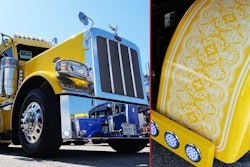Sailboat racing with his buddies washes away a tanker hauler’s stress.
When he’s not in the cab of his tractor, Louis Antoine likes to get his thrills at a bumpy 10 miles an hour.
His passion is to be a crewmember aboard the racing yacht, “Eat A Peach,” crewed by friends on Mobile Bay, Ala.
“I’ll go every chance my schedule lets me go,” he says. “They race Thursday evenings in the summer and on weekends, and if I can make it, there’s no bigger thrill and no better relaxation. I was real nervous the first time, but not any more. I love it.”
The friends, two of whom co-own the boat, race a sleek built-for-speed 1981 Pearson Flyer, 30 feet long from stem to stern and 26 feet long at her waterline, 13 feet across at the widest part of the deck, an 8-foot cabin and drawing 6 feet of water.
“We’ve won some but nowhere near as many as we’ve raced,” Antoine says, laughing. “We give it everything we’ve got, but we also make sure we have a good time. No point in winning if you don’t have a good time.”
Antoine, 53, drives team in a 9400 series International for Amarillo, Texas-based Jack B. Kelley, a tanker company that hauls commodities in bulk nationwide with a fleet of compressed gas, liquid carbon dioxide and cryogenic trailers. Antoine usually hauls argon gas, almost entirely in the South and Southeast, averaging about 5,000 miles on a six on, two off schedule. “We’re kind of like milkmen; we drop some there and some there, some small deliveries, some single large deliveries depending on what the client needs. It’s never the same run twice in a row.”
A Mobile native, Antoine started driving, illegally, when he was 12, hauling logs up to local roads, then left school to work as a mechanic.
“Mechanics didn’t get paid much in those days, and my daddy said he’d break my fingers if that’s what I did,” Antoine says. “I said ‘OK Pop, I’ll find something else.’ So I started driving in an old cabover Ford when I was about 19.”
His career has been driving. He doesn’t mind what he’s driving “as long as it has a steering wheel, a gear shift and a seat and gets me there and back with no trouble; I don’t mind who makes it.”
Today he rolls interstates, but he’s driven long enough to remember when they were unfinished and a driver had to get off, roll along side roads or around cities, then get back onto the next stretch.
And it was those years of driving that brought him to a philosophy today of enjoying his family – he’s been married 29 years with two daughters and three granddaughters (including twins) – and finding ways to take the stress out of life.
Sailing is one of those ways.
“I think one of the main reasons I enjoy sailing in races is that it gets me away from the telephone,” he says. “It’s exciting, but it is also one of the great ways to relax when you get off the road.”
The boat usually carries a crew of six friends, all dedicated to winning. The captain for the race is the man on the tiller, and the other crew members share the jobs of working the hand winches or handling the sails (nothing is motorized on these race boats). Some crew work as counterweights, helping the boat make maximum speed through the water. One man will work as a spotter in the bow, helping the skipper find the best course and steer safely through crowded racing fleets.
“I work the winches sometimes, but mostly I’m there as a counterweight. I’m 6 feet and 295 pounds, so I can handle the job. It’s not just providing weight, though; you have to know how to move. When the boat turns, she turns quickly. You start on the high side, the side farthest above the water, and when she turns you have to get low and get across to the other side. As she turns, the high side becomes the low side, and you have to be across and on the high side to counterbalance the boat as she finishes the turn and starts to move in the other direction.
“Too slow and you are suddenly on the low side of the boat, and your weight is keeping her too low in the water. If you move too late, you can make her much slower through the turn. That’s all lost time, and time is how you win races.”
Also, if you don’t stay low enough on the move from one side to the other, the boom may just land a very powerful, and dangerous, crack to your head.
The race is close even before it starts.
“Every boat is ready at the start, and they just move around like ducks on a pond until it’s time to cross the start line. We have to get to the line as close to our time as possible. Any later and we’ve lost ground to our competitors, and if we cross before our time we lose points.
“Tactics are as much a part of the race as sailing ability. We’ll try to steal the wind away from a rival – ‘take their good air’ – and they’ll try and force us on to a course that costs us time and make us make moves that will slow us down.”
The racers usually take the boat on the three-legged course, one of which will take her into the wind, the slowest of the legs. “That’s when there’s not much to do except wait and occasionally make some small adjustments, break out the drinks and food if you want and kind of catch your breath,” Antoine says.
When the race is over, the boat is docked, and while some of the crew clean her up and stow sails, ropes and gear to leave her ready for the next race, the barbecue comes out. When it’s time to eat, the crew is ready to go back over the race.
“We try to find what we did wrong, what we did right, to learn from the race,” Antoine says. “There are boats that are better than us, but we try to be the best we can.”
More important than the racing itself is the time with friends.
“When we’re not out on the water, sometimes they come over here,” Antoine says. “I stoke up the barbecue, and we cook out and relax and spend time in the garage – we work on my ’66 Ford Galaxie with a 427 and a Lincoln suspension – just enjoying hanging out together.
“We’re all getting a little older, and we have figured out that friends are the most important thing in the world you can have.”






